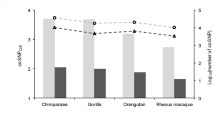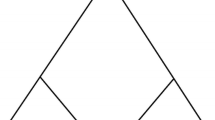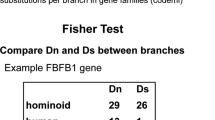Abstract.
We sequenced three argininosuccinate-synthetase-processed pseudogenes (ΨAS-A1, ΨAS-A3, ΨAS-3) and their noncoding flanking sequences in human, orangutan, baboon, and colobus. Our data showed that these pseudogenes were incorporated into the genome of the Old World monkeys after the divergence of the Old World and New World monkey lineages. These pseudogene flanking regions show variable mutation rates and patterns. The variation in the G/C to A/T mutation rate (u) can account for the unequal GC contents at equilibrium: 34.9, 36.9, and 41.7% in the pseudogene ΨAS-A1, ΨAS-A3, and ΨAS-3 flanking regions, respectively. The A/T to G/C mutation rate (v) seems stable and the u/v ratios equal 1.9, 1.7, and 1.4 in the flanking regions of ΨAS-A1, ΨAS-A3, and ΨAS-3, respectively. These ``regional'' variations of the mutation rate affect the evolution of the pseudogenes, too. The ratio u/v being greater than 1.0 in each case, the overall mutation rate in the GC-rich pseudogenes is, as expected, higher than in their GC-poor flanking regions. Moreover, a ``sequence effect'' has been found. In the three cases examined u and v are higher (at least 20%) in the pseudogene than in its flanking region—i.e., the pseudogene appears as mutation ``hot'' spots embedded in ``cold'' regions. This observation could be partly linked to the fact that the pseudogene flanking regions are long-standing unconstrained DNA sequences, whereas the pseudogenes were relieved of selection on their coding functions only around 30–40 million years ago. We suspect that relatively more mutable sites maintained unchanged during the evolution of the argininosuccinate gene are able to change in the pseudogenes, such sites being eliminated or rare in the flanking regions which have been void of strong selective constraints over a much longer period. Our results shed light on (1) the multiplicity of factors that tune the spontaneous mutation rate and (2) the impact of the genomic position of a sequence on its evolution.
Similar content being viewed by others
Author information
Authors and Affiliations
Additional information
Received: 10 February 1997 / Accepted: 21 April 1997
Rights and permissions
About this article
Cite this article
Casane, D., Boissinot, S., Chang, BJ. et al. Mutation Pattern Variation Among Regions of the Primate Genome. J Mol Evol 45, 216–226 (1997). https://doi.org/10.1007/PL00006223
Issue Date:
DOI: https://doi.org/10.1007/PL00006223




